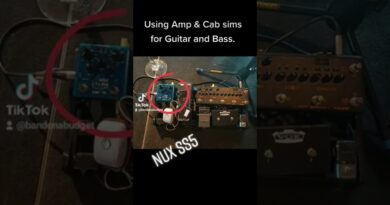CAGED System for Guitar – Part 2: Scales
NOW AVAILABLE! The Complete CAGED Course for Kindle ONLY $3 https://www.amazon.com/dp/B01GUKLJPI
Downloadable diagrams for these and other topics are available at http://www.danmylotte.com/guitarwisdom
In part one of this series (https://www.youtube.com/watch?v=XvJeIb-OceI) we talked about how to locate the proper positions for each of the five CAGED chords in our example key of G major.
Part 2 picks up from there and goes on to explain how a scale pattern overlays each of these five positions.
For a discussion of the theory behind major scales watch this http://youtu.be/cIx2OzKt510?list=UU4SIDuheBZIbWC9cQkiQWkw
For a discussion about minor scales click here http://www.youtube.com/watch?v=Ie6VdGagoCs&feature=youtu.be
#CAGED #System #Guitar #Part #Scales
Originally posted by UC4SIDuheBZIbWC9cQkiQWkw at https://www.youtube.com/watch?v=VlCDHiJcN5Q




I've tinkerd with guitar for over 10 years I would start and stop because I couldn't figure out how to Practice to learn. I could use the CAGED to find every note but that was about it. So I found your video and it all made sense! I don't mean i'm now a master but I can finally see how this helps and I also see the tremendous amount of reps it will take to get somewhat comfortable. I don't know if i'll ever practice enough and get to where I would love to be but at least now I have a purpose. Thank You Sir.
Hi Dan, thank you for your effort. this videos have been so helpful. a question. when talking about the D shape/scale you say at 4:56 that this is technically a forth position because the first finger stretches and the other three remain fixed. Isn't that the definition of a first position i.e., when the first finger stretches. The fourth position requires a stretch with the fourth finger? No? what am i missing here. Thank you again!
This is such a wonderful video. It puts me closer to zen. You need an afro wig, calm down your voice just s bit, and brush up on your Bob Ross adjectives. "Those were some very happy cords!" Or "watch out for that angry B string, he's always outta phase"
At around 7:30 you mentioned ending on the root note so it sounds like the scale you're working on. I prefer to end on the root and then strum the chord. I heard someone doing it and liked it!
this guy is a master teacher, caged is king
this video helped me so much by teaching me other forms of playing scales through the caged system and it works great and im gonna keep on practicing it
downloadable diagram link doesnt work
More teachers like this!!!
you are the first of many teachers who finally made this click. the lightbulb has been lit. many thanks
what the, i just have to press the bell buttonl man!! its VERY informative! i cant believe you have less than 5k sub! you deserve atleast 250k man! i could not ask for more! best lesson ever VERY INFORMATIVE and well explained!


THANK YOU for the lesson!
can u please add a fretboar chart which involves all the positions at once?
i associate d form with dorian 3 note/ string
Are you serious? This guy is so kind and giving. Thanks for the wonderful explanation and material.
This is glorious, been searching for "root notes guitar scales" for a while now, and I think this has helped. Have you ever come across – Vonizabeth Strumming Magnitude – (search on google ) ? Ive heard some pretty good things about it and my friend got amazing results with it.
Very clearly explained. Thank you
Finally I get it ALL now gosh is that how they all join up thank you so much man.
Don't understand why the forms (patterns) i find on internet is different that the ones you show. In particular D-Form. Here an example of forms i found: http://guitarteacher.com/wp-content/uploads/2010/02/CAGED-in-G-2.png
You're using the Berklee- Leavitt method of scales. The "D" shape you demonstrate is confusing to beginners as it still the G scale from the third fret sixth string using the first finger stretches. Why don't you show the G scale starting on the fourth string by moving the index finger up one fret onto the B string playing the E- F#-and G notes where it actually outlines the "D" shape?
Ken, Toronto
Thanks so much for these videos! I have to say, I've taken a few classes and searched for videos online just trying to make sense of the neck, chords and scales, trying to figure out how it's all connected so I can really understand it instead of mindlessly memorizing everything, your lessons are already helping me a lot, looking forward to watching the rest
What was the reasoning for moving the D form scale away from the natural starting point on the 4th string root and onto the root on the 6th string?
bro u got that diagram backwards and in front the frets wtf
Do these scales apply to any key? I.e does the e form pattern apply to the keys of CAGED?
I don't understand how u got all those scale patterns…I mean in the previous video u showed the chord patterns, but u didn't play only those patterns in the scale…U played many extra notes… I mean same notes, but in places where the chord shapes don't go
still dont get it
great lesson i started learning the caged position before but the teacher didn't explain it like you did. Thank you very much
Correct me if I'm wrong but it seems to me that a good guitarist should know intuitively how many frets to move right or left to go up or down a second or minor third or fourth or sixth and so on. Translating these rules to cover the case where you go up or down a string is pretty simple too. So what more is needed? Sure there are more and less efficient ways to finger a phrase, but that's somewhat subjective isn't it?
Nice
Very good video thank you
Very nice, man. Thank you a lot. It started to make sense to me now…
Have been wanting to unlock some of the mysteries of the fretboard and expand my knowledge of how to create better solos for improv…this is basic stuff for some, but very good for those of us who need a system to draw from. Thank you for these lessons brother!